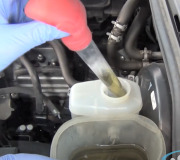This isn't a difficult process, but you will need a helper. To get you started, here is a video showing how it's done. Use this as a guide.
https://youtu.be/w7gUsj2us0U
Here are the directions specific to your vehicle.
____________________________________
Manual Bleed
WARNING: Use of any other than the approved DOT 3 brake fluid will cause permanent damage to brake components and will render the brakes inoperative. Failure to follow these instructions may result in personal injury.
WARNING: Brake fluid contains polyglycol ethers and polyglycols. Avoid contact with eyes. Wash hands thoroughly after handling. If brake fluid contacts eyes, flush eyes with running water for 15 minutes. Get medical attention if irritation persists. If taken internally, drink water and induce vomiting. Get medical attention immediately. Failure to follow these instructions may result in personal injury.
CAUTION: Do not allow the brake master cylinder reservoir to run dry during the bleeding operation. Keep the master cylinder reservoir filled with the specified brake fluid. Never reuse the brake fluid that has been drained from the hydraulic system.
CAUTION: Brake fluid is harmful to painted and plastic surfaces. If brake fluid is spilled onto a painted or plastic surface, immediately wash it with water.
NOTE: When any part of the hydraulic system has been disconnected or a new component is installed, air may enter the system, causing spongy brake pedal action. This requires the bleeding of the hydraulic system after it has been correctly connected.
1. CAUTION: Be sure to check the brake fluid level in the brake master cylinder reservoir often. Do not let it run dry.
Fill the brake master cylinder reservoir with the specified brake fluid.
2. Begin bleeding the system, going in order from the RH rear wheel, to the LH rear wheel, to the RH front wheel and ending with the LH front wheel.
3. Attach a rubber drain hose to the rear bleeder screw and submerge the free end in a container partially filled with clean brake fluid.
4. Have an assistant pump the brake pedal 10 times and then hold firm pressure on the brake pedal.
5. Loosen the bleeder screw until the fluid flow stops. Maintain pressure on the brake pedal and tighten the bleeder screw.
6. Repeat Steps 4 and 5 until clear, bubble-free brake fluid flows.
7. Tighten the bleeder screw to 8 Nm (71 inch lbs.).
Refill the brake master cylinder reservoir as necessary.
8. Continue bleeding the brake hydraulic system at each wheel.
9. Fill the brake master cylinder reservoir with the specified brake fluid.
____________________________
I hope this helps. Let me know if you have other questions.
Take care and God Bless,
Joe
SPONSORED LINKS
Was this helpful?
Yes
No
Friday, April 9th, 2021 AT 2:08 PM
(Merged)




